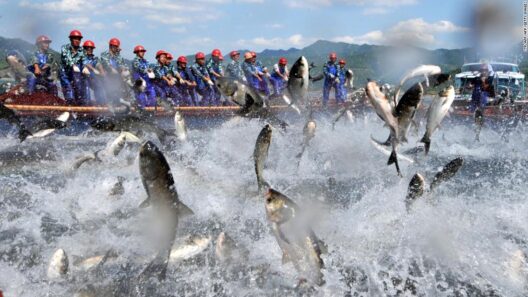Polar bears, the majestic guardians of the Arctic, have evolved an array of remarkable adaptations that enable them to conserve energy in their frigid habitat. Much like human architects who design sustainable buildings, polar bears exhibit an innate understanding of energy efficiency, driven by the unforgiving environment in which they reside. This exploration delves into the intriguing methodologies these iconic mammals employ to optimize their energy use, illuminating their role as nature’s energy savers.
First, let us consider the polar bear’s anatomy. The animal’s thick, insulating layer of blubber, which can measure up to four inches, serves not merely as a buffer against the cold, but as a reservoir of energy. This storehouse enables them to maintain core body temperatures while minimizing the need for excessive physical activity. In a climate where energy expenditure can mean life or death, this adaptation is akin to using a thermal blanket in the dead of winter: it provides warmth and conserves vital energy.
Moreover, their distinctive white fur is more than just a visual marvel; it is an adaptive canvas. The fur, structured with hollow shafts, reflects sunlight while trapping air, offering superior insulation. This clever design reduces the reliance on metabolic heat production, which is akin to wearing a highly efficient, self-regulating thermal suit. By camouflaging seamlessly against the snow, polar bears also conserve energy not solely through temperature regulation but by stealth during hunting, minimizing the energetic costs associated with chasing prey.
Dietary choices play an equally pivotal role in the energy conservation strategies of polar bears. As apex predators, their hunting primarily targets blubbery seals. The high-fat content of seal blubber is a veritable goldmine of energy, allowing bears to consume fewer calories while maximizing nutrient intake. This predilection for energy-dense food is reminiscent of an astute investor strategically choosing assets that yield the highest returns—polar bears opt for the specialization that ensures survival with the least expenditure.
Foraging behavior further exemplifies their energy-efficient design. Polar bears are known to employ a strategic hunt known as still-hunting, where they utilize sea ice to spot seals breathing through holes, waiting patiently in a stoic manner. This method conserves energy compared to more frantic, exhaustive pursuits. While waiting near a seal’s breathing hole can seem like a test of patience, it is precisely this methodical approach that optimizes energy expenditure during hunts. While a seal has the advantage of swift aquatic movement, the bear compensates with tactical patience, embodying a philosophy that encourages measured energy use in the face of primal competition.
Additionally, resting and movement patterns further illustrate their energy-saving mechanisms. Polar bears can go for several days without food if necessary, entering a semi-hibernatory state during which their metabolic rate decreases. This energy conservation strategy resembles a ship’s captain navigating through an unforgiving storm, periodically anchoring to weather the gale and prevent damage to the vessel. In nature, this “fasting” period, although unsettling from a human perspective, ensures that bears can endure long intervals without access to food, which is particularly advantageous during scarcity.
The polar bear’s geographic spread accentuates its energy conservation strategies as well. Relying on expansive territories for hunting, they often traverse vast distances. As such, their movement is calculated and deliberate—essentially a workout in resource management. The extensive ranges are not just about acquiring food; they are about strategic mobility that allows them to exploit varying seasonal conditions, expanding their foraging grounds while conserving energy by following established routes.
Climate change, however, poses grave risks to these ancient custodians of the Arctic, threatening their habitat and, consequently, their energy conservation strategies. Melting sea ice patterns disrupt their ability to hunt effectively, forcing them to expend more energy searching for food. In this sense, climate change serves as a harsh teacher, demonstrating the fragility of energy systems both in wildlife and humanity’s own reliance on stable energy sources. The polar bear serves as a potent reminder of the delicate balance between existence and energy use, driving home the significance of conscientious environmental stewardship.
Notably, the polar bear’s role in the ecosystem extends beyond its own survival; it serves as a barometer for the health of the Arctic environment. The preservation of their habitat is pivotal not just for these bears but for an entire ecosystem relying on cold-water species that connect the food web. By understanding the polar bear’s unique adaptations and energy conservation strategies, we gain insights into larger ecological patterns and the consequences of overexploitation and climate disarray.
In essence, polar bears epitomize nature’s ingenuity in energy conservation. From their meticulously engineered anatomy to their distinctive hunting strategies, each facet of their existence reflects a relentless pursuit of energy efficiency. The Arctic’s apex predator teaches us valuable lessons about adaptation and sustainability—metaphors for our energy habits that echo louder each passing year. We must heed these lessons, acting as stewards of our environment and extracting wisdom from the living tapestry that surrounds us while cultivating an ethos of conservation that can help foster resilience in the face of mounting challenges.
Ultimately, the polar bear serves not just as an awe-inspiring symbol of survival but also as an emblem of the ongoing dialogue surrounding energy use and conservation. Their storied adaptations bridge the gap between the natural world and our energy choices, reminding us that nature, in its boundless intelligence, offers solutions to the pressing challenge of sustainability. We must strive to mirror their practices—to conserve, protect, and cherish the precious resources that our planet has to offer.






